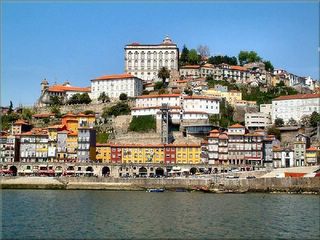PORTO

Situated on the right bank of the River Douro, very close to its mouth, Porto has a historical centre that still preserves quite a strong identity developed throughout the centuries which is clearly visible in its remarkable architecture and the unique livestyle and the great vitality of the local inhabitants (Portuenses, or Tripeiros). This is probably one of the main reasons that in 1996 the city was classified by UNESCO as a World Heritage site. This classification also extends to the neighbouring city of Gaia, on the left bank of the Douro river, taking in the Ponte de D. Luis, the city's emblematic iron bridge, built by a disciple of the famous Gustave Eiffel, the Mosteiro da Serra do Pilar and the wine lodges that line the river bank in Gaia, where most famous product of the city, Port Wine, is left to age before being sent to all corners of the world.

Much is made of the contrast and rivalry between Porto and Lisboa - 'Lisbon shows off, while Porto works' - and the two port cities are the centre of the urban and commercial life of the country. Giving its name to the nation, Porto dates from Roman times, prospering during the age of Portugal's 'Discoveries' as explorers and adventurers sailed to South America, Africa and Asia.

Porto is also the home for the famous Torre dos Clérigos (below), built by Nicolau Nasoni, and its church. The elegant tower is 75m high and has become one of the greatest landmarks of the city. In the street directly opposite to the church, it is definitely worth paying a visit to the Lello bookshop, whose inside is decorated with some quiet remarkable and beautiful carved woodwork.

Porto enjoys some lively eating and drinking. The city of Porto boasts tripa à moda do Porto (Porto-style tripe), supposedly a legacy from the days of Prince Henry the Navigator, when the city was left with nothing but tripe after providing the Infante's ships with food. To this day Porto inhabitants are known as tripeiros, which means exactly tripe-eaters. This dish, famous not so much for its preparation (veal’s tripe with sausages and butter beans) as for the altruistic attitude of the Porto people who, in a moment of need, donated all the available meat to the ships leaving to conquer new cities in Northern Africa and kept only the animals’ tripe for their subsistence, is today’s major symbol of the city’s gastronomy.
You will also have to try the very typical 'Francesinha'. This is the evening dish in Porto, the city’s late night or fast food choice. A Portuguese emigrant in France introduced the recipe in the 60s as an innovative croque-monsieur. Delicious with a beer!
There, you can sample 100s of varieties of port wine at the upmarket Solar do Vinho do Porto, or anywhere else you might go. You should definitely not miss the excellent, and still not internationally renowned, white Port wine.
There's also a thriving club scene too, though many of them are situated outside the centre and you will need some sort of transportation to get there.
